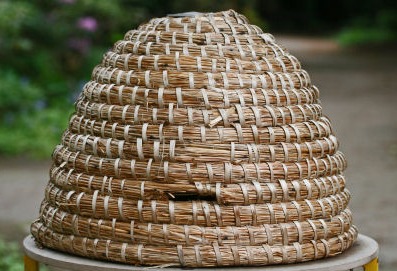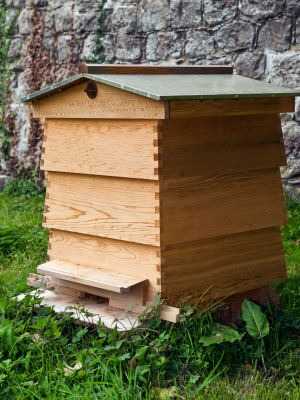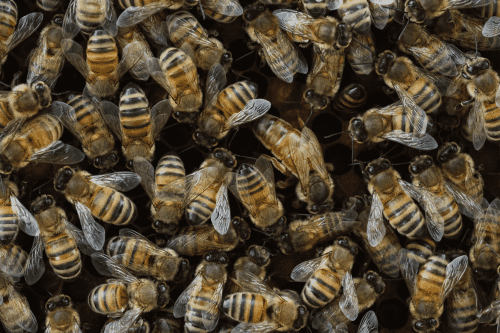Types Of Honey Bee Hives
There are a number of different types of honey bee hives. Some are more
popular than others, and in part, this may depend upon the country in
which you live.
So which bee hive is best? To an extent, your view will depend on your philosophy with regard to beekeeping, and why you wish to become a beekeeper.
In the past, skeps (pictured below) – essentially straw baskets - were used, both for capturing and housing the bees.
Nowadays, skeps may be used more commonly for capturing swarms. (Read more about the history of beekeeping).

Here is a description of some of the types of honey bee hives available.
Top Bar Hives

The top bar hive pictured above is by Phil Chandler, a prominent beekeeper in the 'Natural Beekeeping' movement.
It is taken from his free download explaining how to build such a top bar hive, and a link to that page is featured below - see top bar bee hive plans.
These types of hives
are designed to allow the honey bees to make their own honey combs and cells
according to the size and shape they desire.
Vertical or
horizontal top bar hives may be used. The vertical top bar hive was
especially advocated by Emile Warré (pictured below) in the early twentieth century.
He designed the Warré hive, which he also called ‘The People’s Hive’. It is advocated today by people such as Dr David Heaf, author of The Bee-friendly Beekeeper.
In general, Natural Beekeeping aims for a low level of interference by humans, with Warré beekeeping traditionally advocating the least interference of all the methods. However, all beekeeping is a form of domestication - if only temporarily.
What Are The Conventional Types Of Honey Bee Hives?
The Langstroth Hive

These types of hive are widely used in the USA. This hive design has a deep brood box and about ten frames.
The National Hive
These hives are commonly used in Britain and Europe, and are similar to the Langstroth hive above.
WBC Hive

This hive - featured above - was designed
by William Broughton Carr around 1890. In Britain, this type of hive is the image
many people have of the traditional bee hive. Often thought of as being
inconvenient to have and dismantle.
Dadant Hive
Again, similar to a Langstroth Hive, and all the parts are interchangeable. The Dadant is often used in France and also in some parts of Spain.
Smith Hive
Used sometimes in Scotland. Holds 13 frames, and built to similar dimensions as a National Hive.
Commercial Hive
Having the same dimensions as a National Hive, this type of honey bee hive is designed to encourage a large volume of honey in the supers.
A few thoughts about the honey bee hive.....
It’s always worth
remembering how, honey bees survive in
the wild.
Authors such as Dr David Heaf have long advocated api-centric beekeeping. As stated above, Heaf himself uses Warre hives.
More recently, Thomas D. Seeley has gathered years of research data and scientific experience to understand how beekeepers could become more api-centric, so that healthy, more robust colonies are reared.
I recommend his excellent book - The Lives Of Bees.
In the wild, honey bees naturally seem to like to nest in the cavities of trees, caves or buildings. In doing so, they manage to reproduce and establish new colonies to continue generations of bees.
The honey bees make their own combs with a structure and cell size deemed by the bees to be appropriate for larvae and storing the honey. They will then eat the honey they have stored in the honey combs during the winter months when forage is scarce and conditions mean they avoid venturing out of their nest.
Honey bee hives, however, were invented by man, as a way to exploit them for honey, but if we wish to continue harvesting honey, it is incumbent on us to look at bee hive design, just as Chandler, Heaf, Bell and Seeley have done, with the aim of providing the best solution for the bees themselves, so that beekeeping is as api-centric as possible.
If you found this page helpful or interesting, I'd really be grateful if you would share it with others - if not this page, perhaps another, such as Gardening For Bees.
Thank you so much :) .
